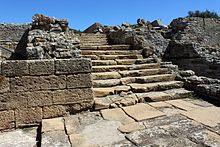
Back كارتيا Arabic كارتيا ARZ Carteia Catalan Carteia German Carteia Spanish Carteia French Carteia Portuguese Картея Russian
 Roman forum in Carteia. | |
| Location | San Roque, Province of Cádiz, Andalusia, Spain |
|---|---|
| Coordinates | 36°11′08″N 5°24′30″W / 36.185524°N 5.408301°W |
| Type | Settlement |
| History | |
| Founded | 940 BC |
| Cultures | Phoenician Carthaginian Roman |
| Site notes | |
| Condition | Partially excavated remains |
| Public access | Yes |

Carteia (Ancient Greek: Καρτηίᾳ)[1] was a Phoenician and Roman town at the head of the Bay of Gibraltar in Spain. It was established at the most northerly point of the bay, next to the town of San Roque, about halfway between the modern cities of Algeciras and Gibraltar, overlooking the sea on elevated ground at the confluence of two rivers, nowadays called Guadarranque and Cachon.[2]
According to Strabo, it was founded around 940 BC as the trading settlement of Kʿrt (meaning "city" in the Phoenician language; compare Carthage and Cartagena).[clarification needed] The area had much to offer a trader; the hinterland behind Carteia, in the modern south of Andalusia, was rich in wood, cereals, oranges, lemons, lead, iron, copper and silver. Dyes were another much sought-after commodity, especially those from the murex shellfish, used to make the prized Tyrian purple.[3] Strabo and Pomponius Mela, mention that some believe that Carteia used to be the Tartessos.[4][5] Pliny the Elder writes that Carteia was called by the Greeks Tartessos.[6]
The town's strategic location meant that it played a significant role in the wars between Carthage and the Roman Republic in the 2nd and 3rd centuries BC. It may have been the site of Hamilcar's landing with his army and elephants in 237 BC, and in 206 BC the Carthaginian admiral Adherbal retreated there with the remnants of his fleet after being defeated by Gaius Laelius in the Battle of Carteia. Around 190 BC, the town was captured by the Romans.[3]
- ^ Dio Cassius, Histories, §43.40
- ^ Calpensis (March 1816). "Account of ancient Carteia, and its Remains". Gentleman's Magazine. Vol. 86. p. 209.[better source needed]
- ^ a b Hills, George (1974). Rock of Contention: A history of Gibraltar. London: Robert Hale & Company. p. 16. ISBN 0-7091-4352-4.
- ^ Strabo, Geography, §3.2.14
- ^ Pomponius Mela, Chorographia, §2.96
- ^ Pliny the Elder, Natural History, §3.3.3
